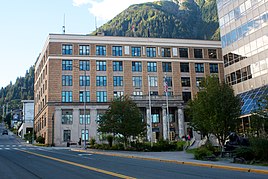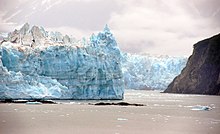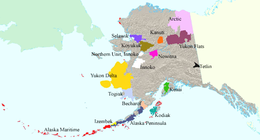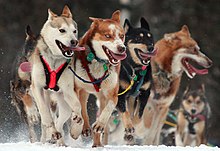Alaska
| Alaska | |||||
|---|---|---|---|---|---|
| |||||
| List of states | |||||
| Capital: | Juneau | ||||
| State motto: | North to the Future | ||||
| Official language : |
de jure : none de facto : English and 20 indigenous American languages |
||||
| Surface: | 1,717,854 km² | ||||
| Residents: | 739,795 (2017 estimated) (0.4 U. / km²) | ||||
| Member since: | 3rd January 1959 | ||||
| Time zone: |
UTC − 9 ( AKST ) UTC − 8 (daylight saving time) Aleutian Islands: UTC − 10 ( HAST ) UTC − 9 (daylight saving time) |
||||
| The highest point: | 6190 m ( Denali ) | ||||
| Average Height: | 580 m | ||||
| Deepest point: | 0 m ( Pacific Ocean ) | ||||
| Governor : | Mike Dunleavy ( R ) | ||||
| Post / Office / ISO | AK / Alas. / US AK | ||||
| Map of Alaska | |||||
| Alaska State Capitol (2010) | |||||
Alaska ( Engl. Pronunciation [ əlæskə ] , of aleutian Alaxsxax , pronunciation [ a'laχshaχ ], "Land, towards which the sea flows" over Russian Аляска [ ɐlʲæskə ] ) is 1,717,854 sq km of which 1,481,346 sq km Land is the largest (almost 17.5% of the total area), the northernmost and westernmost state of the United States of America and the largest exclave on earth. Alaska has the fourth lowest population of any state (just 0.22% of the total US population). The USA acquired the area from the Russian Empire in 1867 ; on January 3, 1959, it became the 49th state in the United States. Alaska is nicknamed the Last Frontier ("Last Frontier"). The Alaska Permanent Fund is a financial policy specialty .
geography
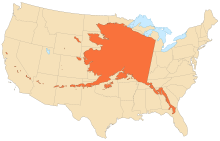
Alaska consists of three major landscapes: the mountain range along the entire southern Pacific coast, the Yukon lowland with its mountainous and hilly terrain, and the coastal plain (“ North Slope ”) on the Arctic Ocean.
The largest river or stream in the country is the Yukon River , which has its source in the Canadian Rocky Mountains , cuts through central Alaska and flows westward and flows into the Bering Sea. To the east, Alaska borders the Canadian Yukon Territory .
There are thousands of lakes in the area of Alaska, the largest of which (Becharof, Iliamna , Naknek and Ugashik) are located on the Alaska Peninsula or at the transition from the mainland to this peninsula.
In the southwest of Alaska lies the narrow Alaska Peninsula , to which the Aleutians adjoin; Both on the peninsula and on the elongated chain of islands is the Aleutian chain , which rises up to 3109 m in Mount Redoubt . In the northern central part of the US state lie the mountains of the Alaska range , to which Denali (Mount McKinley) also belongs - at 6190 m the highest mountain in this range and in all of North America . In the arctic north the Brooks range rises up to a height of 2749 m. In the southwest, the project Wrangell Mountains in Mount Blackburn to 4996 m, the Waxell-Barkley Ridge to 3261 m and to Canada bordering Saint Elias Mountains with the past in Alaska Mount Saint Elias to 5489 to meters. In the extreme southeast is the Alaska Panhandle ("pan handle"), a narrow strip along the Pacific, west of the Canadian province of British Columbia , most of which can only be reached by ship or plane. The capital Juneau is also located there . The remaining areas of Alaska are characterized by partly very densely forested hill countries and countless fjords on the coast.
The mountain system along the Pacific coast is geologically unstable, plate tectonic processes around the Pacific plate make the southeast coast and the Aleutians part of the Pacific Ring of Fire . It is volcanically active and causes earthquakes and seaquakes. The south side is heavily glaciated: The Malaspina in southeast Alaska near the coast of the Gulf of Alaska is the largest extra-polar mountain glacier on earth with 4275 km². At its thickest point the approximately 100 km long and up to 65 km wide glacier is more than 600 m thick. The central part of the state includes the lowlands of the Yukon and the Kuskokwim Rivers. The coastal plain in the north gradually descends from the Brooks range to the Arctic Ocean.
To the Aleutian Islands belonging Rat Islands , and Near Islands are the only areas of the US, whose Longitude is given in an easterly direction, they are between 170 ° and 180 ° East.
As Alaskan Bush all parts of the state are called, which are not connected to the North American road network or the Alaska Marine Highway can be achieved.
To the east, Alaska is bordered by the Canadian Yukon Territory , to the west by the Bering Sea, to the north by the Arctic Ocean and to the south by the Gulf of Alaska , which is part of the Pacific Ocean .
Administrative division
Alaska is not divided into counties like the other states , but into boroughs , which are similar to the counties in the other states, the counties in Germany and the districts in Austria , as well as the Unorganized Borough , which is in Census Areas (census areas) without public administration, which is not set by the state of Alaska but by the U.S. Census Bureau.
climate
In the interior of Alaska there is a continental, in the west a subpolar and in the north a polar tundra climate. The winters here are long, dark and very cold. In the short summer it can get quite warm, on the north coast the temperatures rise above 0 ° C. Even on the peaks of the mountains north of the Rocky Mountains (up to 3000 m), much of the snow melts in summer. Except for the summer months, there is little precipitation (100–300 mm), mostly in the form of snow. On the south and west coast it is more moderate and rainier. Here, even in winter, temperatures rarely fall below –10 ° C, and summers are only moderately warm. But it is very humid, there are sometimes 300 rainy days per year. In the south of Alaska, the glaciers sometimes extend to the sea.
Alaska's previous heat record was measured on June 27, 1915 at 37.8 ° C in Fort Yukon .
Climate diagram of Anchorage
Cold Bay climate diagram
Fairbanks climate diagram
Juneau climate diagram
Climate diagram of Kodiak Island
Climate diagram from Nome
Alaska is one of the regions of the world in which global warming is making itself felt. According to evaluations by Berkeley Earth , the average temperature in Alaska rose by about 2 ° C from 1970 to 2005. As a result of climate change, the number of fires in boreal forest areas has increased and reached a level that, according to a study, has not been reached in the past 10,000 years. For example, several wildfires were recorded in Alaska in 2019.
population
| Population development | |||
|---|---|---|---|
| Census | Residents | ± in% | |
| 1880 | 33,426 | - | |
| 1890 | 32,052 | -4.1% | |
| 1900 | 63,592 | 98.4% | |
| 1910 | 64,356 | 1.2% | |
| 1920 | 55.036 | -14.5% | |
| 1930 | 59,278 | 7.7% | |
| 1940 | 72,524 | 22.3% | |
| 1950 | 128,643 | 77.4% | |
| 1960 | 226.167 | 75.8% | |
| 1970 | 300,382 | 32.8% | |
| 1980 | 401.851 | 33.8% | |
| 1990 | 550.043 | 36.9% | |
| 2000 | 626.932 | 14% | |
| 2010 | 710.231 | 13.3% | |
| Before 1900
1900-1990 2000 |
|||
Alaska has 738,432 inhabitants (as of 2015), of which 66.7% are white, 14.8% indigenous ( Indians , Eskimo and Aleutians , highest percentage in the USA), 5.5% Hispanics or Latinos , 5.4% Asian Americans , 3.3% African American, and 0.6% Hawaiian or Pacific Islander . There are 258,058 households.
Age and gender structure
The age structure of Alaska is composed as follows:
- up to 18 years: 132,440 (18.7%)
- 18–64 years: 522,853 (73.6%)
- from 65 years: 54,938 (7.7%)
The median age is 33.8 years. 52.0% of the population is male and 48.0% is female.
Ethnic composition of the population
15.1% of the population are of German descent , that is about 49,000 and thus constitute the largest group. This is followed by the Irish (10.6%), English (8.2%) and Norwegian (3.6%) groups. (Status 2014) Despite the region's long Russian past, the proportion of people of Russian descent is 1, 1% relatively low. Today, their legacy is mainly reflected in numerous toponyms and field names . An exception is the locality ( CDP ) Nikolaevsk on the Kenai Peninsula , where in 2000 two thirds of the population still spoke Russian on a daily basis .
Religions
The religious communities with the largest number of members in 2000 were the Catholic Church with 54,359 and the Southern Baptist Convention with 22,959 followers. It was followed by the Orthodox Church with approximately 20,000 members and the Church of Jesus Christ of Latter-day Saints with 19,019 members. In statistical surveys, 33% of US citizens living in Alaska said they belonged to a religious denomination. The various evangelical churches together have around 78,000 followers.
The comparatively high number of Orthodox Christians can be traced back to the proselytizing of the native Indians during the Russian colonial period. Most of the Orthodox Christians in Alaska have Native American ancestors.
Biggest cities
In addition to the capital Juneau , Anchorage , by far the largest city in the state, and Fairbanks are the most important cities in Alaska.

history
Settlement and indigenous people
Alaska was the first part of the American continent to be settled by humans. Coming from Siberia , according to a current hypothesis, the first nomads reached the area probably around 36,000 years ago via the Beringia , a land bridge between Asia and North America, which still existed at the time . Until about 18,000 BC Genetic contacts to Siberia are said to have existed. Around this time, the American population finally split off from the Asian. According to the study, all of today's North and South American Indians are said to be descended from these settlers . Other waves of immigration - as many older studies postulate - are said to have not occurred (with the exception of the oldest ancestors of the Inuit ). Only at the end of the Ice Age did the sea level rise, and around 10,000 years ago the two continents were separated by today's Bering Strait . From these first people in the region, the present-day indigenous tribes formed , thousands of years before the European colonization. In what is now southeastern Alaska, as in parts of British Columbia and the Yukon , the Tlingit settled and developed a matrilineal form of society. In addition, the Haida lived in southeast Alaska, and today they are mainly known for their (handicraft) art. The Tsimshian people relocated from British Columbia to Annette Island when American President Grover Cleveland and Congress gave them permission in 1887. There they founded the Metlakatla settlement . These three peoples, as well as other indigenous people of the north-west coast , suffered from various outbreaks of smallpox in the late 18th century until the 1950s ; The outbreaks in the 1830s and 1860s were particularly devastating , with numerous deaths.
The Aleutians are still the homeland of the Aleutian people today , although they were among the first peoples to be exploited by the Russians. Western and southwestern Alaska are home to the Yupik ; their cousins, the Alutiiq , preferred today's central Alaska. The Gwich'in people , best known for their dependence on the caribou stocks, lived in north central Alaska, in the Arctic National Wildlife Refuge . The North Slope and Little Diomede Island are inhabited by different Inuit peoples .
Russian colonization
The first European to sight Alaska was possibly the Russian explorer Semyon Deshnev , who circumnavigated the Chukchi Peninsula in 1648, refuting the thesis that America and Asia are connected. In 1728 and 1729, the Dane Vitus Bering, sailing on behalf of the Russian Tsar, failed in his attempt to reach Alaska. It was not until 1732 that Afanassi Shestakov Mikhail Gwosdew set foot on the mainland at Cape Prince of Wales as part of the expedition . It was not until 1741 that Alaska was re-entered as part of the second Kamchatka expedition. The Russian Alexei Tschirikow , captain of St. Paul , the second ship of Bering's expedition, sighted land near the Prince of Wales Island on July 25 of this year . Bering reached the coast about 600 km further north the next day - the ships had previously been separated in a storm. On the return voyage, the St. Peter , Bering's ship, had to land on the island that was later named after him and where he died on December 19, 1741. The rest of the crew returned to the port of departure on September 6, 1742, today's Petropavlovsk on Kamchatka . The observations of the botanist and zoologist Georg Wilhelm Steller , who described some American animal and plant species for the first time, including the Steller manatee named after him and exterminated in 1768, were also of importance on this expedition .
From 1745 the Russians explored their future colony, Russian America, in search of sea otters and their valuable furs. Because of the great distances and the adverse climate, these ventures were extremely risky. In 1783 Grigori Shelichov landed on the island of Kodiak with two ships . He had fire opened against the unwilling Koniag Eskimo and killed or wounded hundreds. He established the first permanent settlement of colonists in Alaska at what is now Three Saints Bay . In 1792 the settlement was moved to the place of today's town of Kodiak , which developed into the main trading point for fur, also from the mainland.
The Russian expansion soon faced Spain and Great Britain. Spain laid claim to the entire American Pacific coast based on the Treaty of Tordesillas of 1494. In order to support this claim, King Charles III sent. between 1774 and 1791 several expeditions to explore them. One of two ships on the second expedition reached Alaska in 1775 under Juan Francisco de la Bodega y Quadra . In 1791 this was also achieved by the Italian Alessandro Malaspina , who was in Spanish service and who was looking for the Northwest Passage on behalf of the Crown ; the Malaspina glacier is named after him . The village of Valdez is founded in Spain . The differing views of the Spanish and British led to the Nootka Sound crisis in 1790. In the course of the Latin American independence movement that began in 1810, Spain's interests shifted. The border between Russian America, Great Britain and the USA was specified in treaties in 1824 and 1825, respectively.
As early as 1778 the Briton James Cook roughly mapped the course of the Pacific coast from California to the Bering Strait and found the Cook Inlet named after him . George Vancouver continued these ventures 1791–1795. In the next few years, British and American fur hunters and traders increasingly flocked to Alaska by ship. The British Hudson's Bay Company only had trading posts in Fort Yukon , on the Stikine River and in Wrangell from the 1830s, some of which came about through lease agreements with the Russians. Later, however, these were given up in favor of the new foundations further south, particularly in what is now British Columbia .

By 1798 Alexander Baranow explored the coastal areas south of Kodiak and in 1799 founded a branch about 10 km north of today's Sitka in order to emphasize Russia's sole claim.
The three largest remaining fur animal companies, among them the Schelichow-Golikow-Gesellschaft co-founded by Schelichow, merged in 1799 under the initiative of Schelichow's son-in-law, Nikolai Resanow , to form the Russian-American Company (RAK), and Tsar Paul I for twenty years Monopoly of the fur trade in Alaska granted.
Resanov planned to take possession of the entire Pacific coast of North America for Russia. In 1805 he reached the Bay of San Francisco , but his early death the following year and the caution of the Russian Tsar thwarted these plans. In 1812 the deputy Ivan Kuskow built the Fort Ross trading post in California on the instructions of Baranov, less out of a claim to power than as a necessary supply base . It was sold in 1841.
Russian America became more and more important for the Tsarist Empire, too important for the colony to be run by a fur trader like Baranov. In 1818 Baranow was replaced, the Russian government took control with Russian naval officers and initially appointed Ludwig von Hagemeister as governor. Ferdinand von Wrangel was one of the governors of the colony, which existed until 1867 .
Selling Alaska
Alaska was for the emerging world power Russia the only overseas - colony , which was but hardly profitable and difficult to manage. Since the passage through the Arctic Ocean was too dangerous, the only way from the Russian capital of St. Petersburg at the time led across the country across the Chukchi Sea and took more than half a year.
Over time, the fur animals , especially the sea otters , became increasingly rare as a result of hunting and the territory became more and more difficult for Russia to maintain. In addition, the native Indians, especially the Tlingit , made difficulties for the Russians. In order to replenish the treasury after the lost Crimean War , Tsar Alexander II agreed to a contract that his ambassador to the USA, Eduard von Stoeckl , had signed with US Secretary of State William H. Seward in Washington on March 30, 1867 . After that, the tsarist empire sold Alaska for 7.2 million dollars (equivalent to the current equivalent of 130 million dollars) to the United States (Alaska Purchase).
That purchase was one of the cheapest land purchases in history, at just $ 4.74 per square kilometer. The purchase was nevertheless very controversial in the USA. The Senate approved the purchase agreement with 37 yes and 2 no votes, but scoffers called the acquired land Seward's ice box (“Seward's freezer”) or “ Johnson's polar bear enclosure”. On October 18, 1867, Alaska officially passed into American ownership; in Sitka the Russian flag was lowered and the flag of the USA was hoisted. Due to the introduction of the Gregorian calendar, this official handover day of Russian America to the USA has two dates, October 6th ( Julian calendar ) and October 18th ( Gregorian calendar ), which is still a public holiday ("Alaska Day") and celebrated especially in the old capital Sitka.
Alaska as a part of the United States
1867–1877 Alaska was administered by the United States Army , 1877–1879 by the Treasury Department and 1879–1884 by the Navy . Until 1884, the name of the area was Department of Alaska . Triggered by the Klondike gold rush in 1898, the border with Canada was precisely fixed in 1903. From 1884 to 1912 Alaska had its own government as the District of Alaska and from 1912 to 1959 as the Alaska Territory a seat in the United States Congress . On January 3, 1959, the Alaska Statehood Act made Alaska the 49th state in the United States of America .
oil
In 1968, huge oil fields were discovered on the polar sea coast at Prudhoe Bay . This led to the construction of the Trans-Alaska Pipeline from Prudhoe Bay to Valdez in 1974–1977 . In 1989 there was a serious accident with an oil tanker ( Exxon-Valdez disaster ). The ship ran aground with a simple outer hull, and the leaked oil contaminated Alaska's sensitive ecosystem. As a result, the Americans changed their regulations and only allowed safer double-hull tankers to enter their ports.
It is estimated that the oil field discovered in 1968 will be exhausted around 2020 - however, another huge oil field was discovered further north a few years ago.
politics
On October 19, 2005, a particularly liberal gun law came into effect in the state of Alaska at the instigation of the National Rifle Association . According to the will of the NRA, Alaska is to become a model for the other states. This is indicative of the political culture of the frontier spirit , which ties in with traditions of the old American West that are libertarian in terms of property and yet emphasize the social order. The state is therefore predominantly conservative, but without religion playing a similarly important role as in more traditionally structured states in the USA. After the Republicans Frank Murkowski , Sarah Palin and Sean Parnell had served as governors since 2002 , the independent candidate Bill Walker was elected to this office in 2014. In 2018 he was replaced by Mike Dunleavy , a Republican. Republicans Lisa Murkowski and Dan Sullivan belong to Congress as senators ; the only member of the state in the United States House of Representatives since 1973 is Don Young .
congress
Members of the 116th Congress
| Surname | Member since | Party affiliation | |
|---|---|---|---|
| Don Young | 1973 | republican |
| Surname | Member since | Party affiliation | |
|---|---|---|---|
| Lisa Murkowski | 2002 | republican | |
| Dan Sullivan | 2015 | republican |
- List of members of the US House of Representatives from Alaska
- List of United States Senators from Alaska
Presidential election
On November 8, 1960 , Alaska was allowed to participate in a US presidential election for the first time . With the exception of the 1964 election , in which Democrat Lyndon B. Johnson received the Alaskan electoral vote, Republican candidates always won the election in Alaska.
The most successful Republican presidential candidate in Alaska was Ronald Reagan when he was re-elected in 1984 , with around 67 percent of the vote.
In 1992, 73,481 of Alaska's voters, representing 28.43 percentage points of the vote, voted Ross Perot . It was the best result from a candidate who did not belong to either of the two major parties.
| year | Candidate (winner) | percent | be right | Candidate (loser) | percent | be right | Other parties |
|---|---|---|---|---|---|---|---|
| 2016 | Donald Trump (R) | 51.28 | 163,387 | Hillary Clinton (D) | 36.55 | 116.454 | 12.17% (38,767) |
| 2012 | Mitt Romney (R) | 54.80 | 164,676 | Barack Obama (D) | 40.81 | 122,640 | 4.39% (13,179) |
| 2008 | John McCain (R) | 59.42 | 193,841 | Barack Obama (D) | 37.89 | 123,594 | 2.69% (8762) |
| 2004 | George W. Bush (R) | 61.07 | 190,889 | John Kerry (D) | 35.52 | 111.025 | 3.42% (10,684) |
| 2000 | George W. Bush (R) | 58.62 | 167,398 | Al Gore (D) | 27.67 | 79.004 | 13.71% (39,158) |
| 1996 | Bob dole (r) | 50.80 | 122,746 | Bill Clinton (D) | 33.27 | 80,380 | 15.92% (38,494) |
| 1992 | George Bush (R) | 39.46 | 102,000 | Bill Clinton (D) | 30.29 | 78.294 | 30.26% (78,212) |
| 1988 | George Bush (R) | 59.59 | 119.251 | Michael Dukakis (D) | 36.27 | 72,584 | 4.14% (8281) |
| 1984 | Ronald reagan (r) | 66.65 | 138,377 | Walter Mondale (D) | 29.87 | 62.007 | 3.48% (7221) |
| 1980 | Ronald reagan (r) | 54.35 | 86,112 | Jimmy Carter (D) | 26.41 | 41,842 | 19.24% (30,491) |
| 1976 | Gerald Ford (R) | 57.90 | 71,555 | Jimmy Carter (D) | 35.65 | 44,058 | 6.44% (7961) |
| 1972 | Richard Nixon (R) | 58.13 | 55,349 | George McGovern (D) | 34.62 | 32,967 | 7.25% (6903) |
| 1968 | Richard Nixon (R) | 45.28 | 37,600 | Hubert H. Humphrey (D) | 42.65 | 35,411 | 12.07% (10,024) |
| 1964 | Lyndon B. Johnson (D) | 65.91 | 44,329 | Barry goldwater (r) | 34.09 | 22,930 | - |
| 1960 | Richard Nixon (R) | 50.94 | 30,953 | John F. Kennedy (D) | 49.06 | 29,809 | - |
Governors and Deputies
Debate over status
In Alaska there is an independence movement (Alaska Independent Movement), whose followers see themselves as Alaskans instead of US-Americans and strive for secession from the USA and an independent republic. For this she demands the support and recognition of the UN . The Alaskan Independence Party , which represents them, had a one-off success in 1990 with the election of Walter Hickel (US Secretary of the Interior under Richard Nixon ) as Governor of Alaska (Hickel returned to the Republican Party in 1994) and was given a boost by the autonomy of Nunavut in 1999 .
In addition, there were and are further debates, some of them curious:
- Russian right-wing populist Vladimir Zhirinovsky has repeatedly called for Alaska to be returned to Russia since 1991. The sale of 1867 was illegal. Owning Alaska would also further strengthen Russia's comfortable position in the Arctic dispute , as the USA currently has a small sectoral share of the northern polar region via Alaska.
- In 1989, Libya's revolutionary leader Muammar al-Gaddafi proposed Alaska as a home for the Jews instead of Palestine . With a similar proposal, Iran's President Mahmoud Ahmadineschād turned the western world against him.
death penalty
In 1957, before joining the American Union as a state, the Alaska Territory abolished the death penalty . This was perceived by the indigenous peoples as well as by the whites as colonial and brutal jurisdiction. Efforts to reintroduce the death penalty from 1997 onwards failed in the State Legislature , primarily because of the fact that life imprisonment is cheaper for the state.
Culture and sights
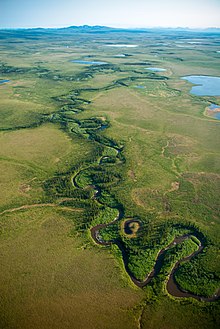
National parks
Natural monuments
There are five National Monuments in Alaska :
- Admiralty Island National Monument
- Aniakchak National Monument and Preserve
- Cape Krusenstern National Monument
- Misty Fjords National Monument - the largest national monument in the United States
- World War II Valor in the Pacific National Monument
There are also 16 National Natural Landmarks (as of September 30, 2017).
Protected areas
There are 16 National Wildlife Refuges in Alaska :
Cultural monuments

The National Park Service has 49 National Historic Landmarks and 430 entries on the National Register of Historic Places for Alaska . In addition, the National Heritage Area includes the Kenai Mountains-Turnagain Arm National Heritage Area (as of September 30, 2017).
Culture
One of the most popular annual events in Alaska is the Iditarod dog sled race, which starts in Anchorage and ends in Nome ; the Ice Art World Championships always take place in Fairbanks . In Ketchikan , the place Blueberry Festival and the Alaska Hummingbird Festival held; there is also the Stikine River Garnet Fest in Wrangell . In spring, the world's largest concentration of bald eagles can be seen on the Stikine River .
music
Alaskan music is heavily influenced by traditional native music as well as folk music brought with them by Russian and European immigrants. Well-known musicians from Alaska include the singer Jewel and the Aleut flautist Mary Youngblood .
There are numerous music festivals in Alaska, including the two largest cities in the state, Anchorage and Fairbanks . The main orchestra in the state is the Anchorage Symphony Orchestra , although those of Fairbanks and Juneau are now better known. The Anchorage Opera is currently the only professional company in Alaska; there are also a few amateur and semi-professional orchestras in the state.
Newspapers
The most important national daily newspaper is the Anchorage Daily News, founded in 1946 . Around 30 local newspapers appear in the widely separated places, mostly weekly. They have names like “Nome Nugget” and were initially something of a mouthpiece for Eskimos and Indians.
Sports
Alaskan athletes regularly take part in the Arctic Winter Games . These games also include athletes from Nunavut , the Northwest Territories and the Yukon, as well as Nunavik , northern Alberta and Greenland .
Economy and Infrastructure
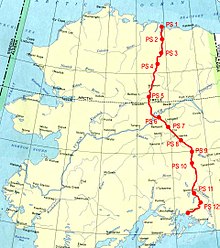
Alaska is one of the most economically successful states in the USA. The real gross domestic product per capita real GDP was USD 68,356 in 2016 (national average of the 50 US states: USD 57,118; national ranking: 6).
economic sectors
The source of wealth is Alaska's oil reserves , which account for around 85 percent of state revenues. Unique in the USA is the Alaska Permanent Fund , which manages the income of the oil business and distributes the annual profit equally among the residents of Alaska. In 2011, every resident of Alaska received additional income from the fund of around USD 1,170 .
Because of the large forest areas, the wood and paper industry is an important source of income. Gold , copper , silver , lead , tin and iron are mined in the mountains . In the fishery , salmon and cod are the main exports. Alaska has coal deposits and an oil line discovered in 1968 . This gives Alaska and the Trans-Alaska Pipeline an important role in the world crude oil market.
Agriculture can only be practiced in the river valleys (for example on the Yukon ). Are grown cereals , vegetables and forage crops, and there are very few crops. Mainly fur animals are bred .
traffic
Country roads
Compared to the Lower 48 , Alaska is only very sparsely accessible by roads. The Alaskan road system covers only a very small area of the state that connects the major centers and the Alaska Highway , the main road to Canada. The state capital, Juneau , is off-road and can only be reached by ferry from the Alaska Marine Highway or through the airport . Several debates have taken place over the years about moving the capital to another location or building a road to Haines .
A unique feature of Alaska's road system is the Anton Anderson Memorial Tunnel , an active rail tunnel that has recently been paved for road vehicles and connects the isolated community of Whittier on Prince William Sound with the Seward Highway about 50 km southeast of Anchorage .
railroad
Since about 1915, the Alaska Railroad (ARR) has played an important role in the development of the state in the 20th century. It connects shipping on the North Pacific via the ports of Seward , Anchorage, Eklutna, Wasilla, Talkeetna to Fairbanks, with branches to Whittier, Palmer and North Pole . In addition, numerous railway lines have been built to natural resource extraction areas, such as from the Usibelli Coal Mine near Healy to Seward and from the Matanuska Valley to Anchorage. These routes are also very popular with tourists in summer. One of the most popular railroad routes with tourists is the White Pass and Yukon Railway , which runs from Skagway over the White Pass over Canadian territory to Carcross .
shipping
Since many settlements in Alaska are not connected to the road system, water connections are also very important. The state ferry system ( Alaska Marine Highway ) connects the villages in the southeast, the Gulf region and on the Alaska Peninsula . The ships transport both passengers and vehicles. There is also a boat connection from Bellingham (Washington State) through the Inside Passage via Prince Rupert to Skagway . The Inter-Island Ferry Authority also serves other ports in the Prince of Wales Island region with the Alaska Marine Highway.
In recent years, various cruise lines have set up a wide range of summer cruises to Alaska, mainly serving the northwest coast and southeast Alaska. The city of Ketchikan can have up to 10,000 visitors on certain days ; when up to four cruise ships are in port at the same time.
Air traffic
Since many places in Alaska can only be reached by plane, there are more than 250 airfields in Alaska, most of them with sand or ice runways, which are primarily used for freight transport to the remote regions. Many seaplanes are also used. Many airlines used Alaska as a stopover on international flights before long-haul aircraft were ready for practical use . In 1957, SAS began to operate the polar route from Copenhagen via Anchorage to Tokyo with Douglas DC-7C , with Anchorage Airport establishing itself as an air hub primarily for freight traffic to Europe and Asia in the 1960s. However, after the 1990s (with the opening of routes via Russia and the introduction of new long-haul aircraft) international air traffic fell sharply. Also, the Fairbanks airport offers international connections and plays mainly for tourism an important role.
See also
literature
- Stephen W. Haycox: Alaska: An American Colony. 2nd Edition. University of Washington Press, Seattle 2020, ISBN 978-0-295-74685-2 .
- Jonathan M. Nielsen, History of Alaska in Three Volumes
- A history of Alaska, Volume I: From Old and New Frontiers to the Changing Strategic Balance. Academia Press, Washington, DC 2018, ISBN 978-1-68053-058-2 .
- A History of Alaska, Volume II: Alaska On the Road to War. Academia Press, Washington, DC 2018, ISBN 978-1-68053-059-9 .
- A History of Alaska, Volume III: Gibraltar of the North. Academia Press, Washington, DC 2018, ISBN 978-1-68053-060-5 .
- Bernd Steinle: Gold rush, ice and bear tracks. Adventurous Alaska. Picus Verlag, Vienna, 2007, ISBN 978-3-85452-928-6 .
- Joel K. Bourne Jr .: The Great Wilderness. In the north of Alaska lies one of the last untouched natural landscapes in America - but the huge oil reserves underneath arouse desires: Their exploitation could destroy this paradise forever. In: National Geographic Germany. June 2006, pp. 44-81.
- Marvin W. Falk (Ed.): Alaska History: An Annotated Bibliography. Praeger, Westport 2006, ISBN 0-313-28224-2 .
- Peter Littke: From the tsar's eagle to the stars and stripes. The history of Russian Alaska. Magnus-Verlag, Essen, 2003, ISBN 3-88400-019-5 .
- Harry Ritter: Alaska's History: The People, Land, and Events of the North Country. Graphic Arts Books, Portland 1993, ISBN 978-0-88240-432-5 .
- James A. Michener : Alaska. Lübbe Verlag, Bergisch Gladbach, 1991, ISBN 3-404-11810-3 (novel).
- Claus-M. Naske, Herman E. Slotnick: Alaska: A History of the 49th State. Second edition. University of Oklahoma, Norman 1987, ISBN 0-8061-2099-1 .
Web links
- Official website of the state of Alaska (English)
- State of Alaska travel information (in German)
- Alaska Department of Fish and Game
Individual evidence
- ↑ Temperature record in Alaska's largest city - 32.2 degrees in Anchorage. In: suedostschweiz.ch . July 5, 2019, accessed July 8, 2019 .
- ↑ tagesschau.de: Climate change in Alaska: A vicious circle takes its course (tagesschau.de archive)
- ↑ Kelly, R., Chipman, ML, Higuera, PE, Stefanova, I., Brubaker, LB, & Hu, FS (2013). Recent burning of boreal forests exceeds fire regime limits of the past 10,000 years. Proceedings of the National Academy of Sciences, 110 (32), 13055-13060. https://doi.org/10.1073/pnas.1305069110
- ↑ https://public.wmo.int/en/media/news/unprecedented-wildfires-arctic
- ↑ US Census Bureau _ Census of Population and Housing , accessed February 28, 2011
- ↑ Excerpt from Census.gov , accessed on February 28, 2011
- ↑ Excerpt from factfinder.census.gov , accessed on February 28, 2011
- ^ US Census Bureau , accessed December 23, 2014
- ^ Census Alaska Selected Social Characteristics
- ^ The Association of Religion Data Archives: State Membership Report: Alaska ( Memento of March 3, 2016 in the Internet Archive ), thearda.com
- ↑ Jörg R. Mettke: Russia's Colony in America . In: Der Spiegel . No. 1 , 2004, p. 90-93 ( online ).
- ↑ Uwe Klußmann: For a handful of dollars . In: Spiegel history . 1/2012, p. 99
- ↑ Stephanie Lahrtz: Ancient Baby DNA Provides Clues to the Settlement of America , Neue Zürcher Zeitung, January 4, 2018
- ^ Brian C. Hosmer: American Indians in the Marketplace: Persistence and Innovation among the Menominees and Metlakatlans, 1870-1920. University Press of Kansas, Lawrence (Kansas) 1999, pp. 129-131, 200.
- ↑ Lydia T. Black: Russians in Alaska, 1732-1867 . University of Alaska Press, Fairbanks 2004, ISBN 1-889963-04-6 , pp. 26 (English, limited preview in Google Book Search).
- ↑ Illustration of the check that paid for the sale of Alaska to the US , ourdocuments.gov
- ^ Primary Documents in American History: Treaty with Russia for the Purchase of Alaska
- ↑ Alaska: History , infoplease.com
- ↑ Election results in detail
- ↑ Alaska Independence Movement , pravda.ru
- ^ Alaskan Independence Party website
- ↑ Who is Muammar al Gaddafi? ( Memento from August 17, 2007 in the Internet Archive ), tagesspiegel.de
- ↑ Muammar al-Gaddafi: The provocateur on a course of relaxation ( memento from February 11, 2013 in the web archive archive.today ), ftd.de
- ↑ "Ahmadinejad wants to transfer Israel to North America" on spiegel.de
- ↑ tagesschau.de: "Horror over Ahmadinejad" ( Memento from June 26, 2009 in the Internet Archive )
- ↑ Ahmadinejad wants to move Israel to Canada or Alaska , heise.de
- ↑ Larry Wayne Koch, Colin Wark, John F. Galliher: The Death of the American Death Penalty: States Still Leading the Way. Northeastern University Press, Lebanon 2012, ISBN 978-1-55553-782-1 , pp. 11f.
- ↑ Alaska. In: nps.gov. Retrieved November 15, 2018.
- ↑ Alaska. In: nps.gov. Retrieved November 15, 2018.
- ^ US Bureau of Economic Analysis: Regional Economic Accounts
- Jump up ↑ Air Crosses in the Wilderness - Alaska's International Airports , Flug Revue January 2010, pp. 56–60
Coordinates: 65 ° 0 ′ N , 151 ° 0 ′ W





